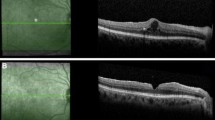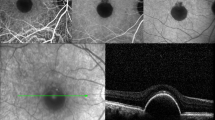Abstract
Purpose
To investigate epiretinal membrane (ERM) formation using en face optical coherence tomography (OCT) after vitrectomy for rhegmatogenous retinal detachment (RRD).
Methods
We retrospectively reviewed the medical records of 64 consecutive eyes (64 patients) with RRD treated by vitrectomy without ERM and internal limiting membrane peeling. ERMs and retinal folds were detected by B-scan and en face imaging. The maximum depth of retinal folds (MDRF) was quantified using en face imaging. ERM severity was staged using B-scan imaging. Main outcome measures were ERM detection rate with B-scan and en face imaging, MDRF, ERM staging, postoperative best-corrected visual acuity (BCVA; logarithm of the minimum angle of resolution), and risk factors for ERM formation.
Results
The detection rate for ERM formation was significantly higher with en face imaging (70.3%) than with B-scan imaging (46.9%; P = 0.007). There was no significant difference in postoperative BCVA between eyes with ERM formation (0.06 ± 0.26) and those without ERM formation (0.01 ± 0.14; P = 0.298). Forty of 45 (88.9%) eyes with ERM formation were classified as stage 1. Twenty-seven of 45 (60.0%) eyes with ERM formation developed parafoveal retinal folds. The mean MDRF was 27.4 ± 32.2 μm. Multiple retinal breaks and a maximum retinal break size of ≥ 2 disc diameters were significantly associated with ERM formation (P = 0.033 and P = 0.031, respectively).
Conclusion
Although ERM formation was observed in 70.3% patients after RRD repair, the formed ERM was not severe and had minimal impact on the postoperative visual acuity.






Similar content being viewed by others
Data availability
Data are available on request.
References
Council MD, Shah GK, Lee HC, Sharma S (2005) Visual outcomes and complications of epiretinal membrane removal secondary to rhegmatogenous retinal detachment. Ophthalmology 112:1218–1221. https://doi.org/10.1016/j.ophtha.2005.01.051
Campo RV, Sipperley JO, Sneed SR, Park DW, Dugel PU, Jacobsen J, Flindall RJ (1999) Pars plana vitrectomy without scleral buckle for pseudophakic retinal detachments. Ophthalmology 106:1811–1816. https://doi.org/10.1016/S0161-6420(99)90353-6
Thompson JA, Snead MP, Billington BM, Barrie T, Thompson JR, Sparrow JM (2002) National audit of the outcome of primary surgery for rhegmatogenous retinal detachment. II Clinical outcomes. Eye (Lond) 16:771–777. https://doi.org/10.1038/sj.eye.6700325
Katira RC, Zamani M, Berinstein DM, Garfinkel RA (2008) Incidence and characteristics of macular pucker formation after primary retinal detachment repair by pars plana vitrectomy alone. Retina 28:744–748. https://doi.org/10.1097/IAE.0b013e318162b031
Kunikata H, Nishida K (2010) Visual outcome and complications of 25-gauge vitrectomy for rhegmatogenous retinal detachment; 84 consecutive cases. Eye (Lond) 24:1071–1077. https://doi.org/10.1038/eye.2010.41
Martínez-Castillo V, Boixadera A, Distéfano L, Zapata M, García-Arumí J (2012) Epiretinal membrane after pars plana vitrectomy for primary pseudophakic or aphakic rhegmatogenous retinal detachment: incidence and outcomes. Retina 32:1350–1355. https://doi.org/10.1097/IAE.0b013e318242b965
Nam KY, Kim JY (2015) Effect of internal limiting membrane peeling on the development of epiretinal membrane after pars plana vitrectomy for primary rhegmatogenous retinal detachment. Retina 35:880–885. https://doi.org/10.1097/IAE.0000000000000421
Akiyama K, Fujinami K, Watanabe K, Tsunoda K, Noda T (2016) Internal limiting membrane peeling to prevent post-vitrectomy epiretinal membrane development in retinal detachment. Am J Ophthalmol 171:1–10. https://doi.org/10.1016/j.ajo.2016.08.015
Forlini M, Date P, Ferrari LM, Lorusso M, Lecce G, Verdina T, Neri G, Benatti C, Rossini P, Bratu A, D’Eliseo D, Ferrari TM, Cavallini GM (2018) Comparative analysis of retinal reattachment surgery with or without internal limiting membrane peeling to prevent postoperative macular pucker. Retina 38:1770–1776. https://doi.org/10.1097/IAE.0000000000001775
Garweg JG, Deiss M, Pfister IB, Gerhardt C (2019) Impact of inner limiting membrane peeling on visual recovery after vitrectomy for primary rhegmatogenous retinal detachment involving the fovea. Retina 39:853–859. https://doi.org/10.1097/IAE.0000000000002046
Eissa MGAM, Abdelhakim MASE, Macky TA, Khafagy MM, Mortada HA (2018) Functional and structural outcomes of ILM peeling in uncomplicated macula-off RRD using microperimetry & en-face OCT. Graefes Arch Clin Exp Ophthalmol 256:249–257. https://doi.org/10.1007/s00417-017-3875-7
Arias L, Padrón-Pérez N, Flores-Moreno I, Giralt L, Cobos E, Lorenzo D, García-Bru P, Dias B, Caminal JM (2020) Internal limiting membrane peeling versus nonpeeling to prevent epiretinal membrane development in primary rhegmatogenous retinal detachment: a swept-source optical coherence tomography study with a new postoperative classification system. Retina 40:1286–1298. https://doi.org/10.1097/IAE.0000000000002591
Fallico M, Russo A, Longo A, Pulvirenti A, Avitabile T, Bonfiglio V, Castellino N, Cennamo G, Reibaldi M (2018) Internal limiting membrane peeling versus no peeling during primary vitrectomy for rhegmatogenous retinal detachment: a systematic review and meta-analysis. PLoS One 13:e0201010. https://doi.org/10.1371/journal.pone.0201010
Alkabes M, Salinas C, Vitale L, Burés-Jelstrup A, Nucci P, Mateo C (2011) En face optical coherence tomography of inner retinal defects after internal limiting membrane peeling for idiopathic macular hole. Invest Ophthalmol Vis Sci 52:8349–8355. https://doi.org/10.1167/iovs.11-8043
Ferrara D, Mohler KJ, Waheed N, Adhi M, Liu JJ, Grulkowski I, Kraus MF, Baumal C, Hornegger J, Fujimoto JG, Duker JS (2014) En face enhanced-depth swept-source optical coherence tomography features of chronic central serous chorioretinopathy. Ophthalmology 121:719–726. https://doi.org/10.1016/j.ophtha.2013.10.014
Fujiwara A, Morizane Y, Hosokawa M, Kimura S, Kumase F, Shiode Y, Doi S, Hirano M, Toshima S, Hosogi M, Shiraga F (2016) Factors affecting choroidal vascular density in normal eyes: quantification using en face swept-source optical coherence tomography. Am J Ophthalmol 170:1–9. https://doi.org/10.1016/j.ajo.2016.07.006
Romano MR, Cennamo G, Amoroso F, Montorio D, Castellani C, Reibaldi M, Cennamo G (2017) Intraretinal changes in the presence of epiretinal traction. Graefes Arch Clin Exp Ophthalmol 255:31–38. https://doi.org/10.1007/s00417-016-3413-z
Hirano M, Morizane Y, Kimura S, Hosokawa M, Shiode Y, Doi S, Toshima S, Takahashi K, Hosogi M, Fujiwara A, Takasu I, Okanouchi T, Kawabata M, Shiraga F (2018) Assessment of lamellar macular hole and macular pseudohole with a combination of en face and radial b-scan optical coherence tomography imaging. Am J Ophthalmol 188:29–40. https://doi.org/10.1016/j.ajo.2018.01.016
Hirano M, Morizane Y, Kanzaki Y, Kimura S, Hosokawa M, Shiode Y, Doi S, Toshima S, Takahashi K, Hosogi M, Fujiwara A, Takasu I, Shiraga F (2020) En face image-based analysis of retinal traction caused by epiretinal membrane and its relationship with visual functions. Retina 40:1262–1271. https://doi.org/10.1097/IAE.0000000000002569
Stevenson W, Prospero Ponce CM, Agarwal DR, Gelman R, Christoforidis JB (2016) Epiretinal membrane: optical coherence tomography-based diagnosis and classification. Clin Ophthalmol 10:527–534. https://doi.org/10.2147/OPTH.S97722
Govetto A, Lalane RA III, Sarraf D, Figueroa MS, Hubschman JP (2017) Insights into epiretinal membranes: presence of ectopic inner foveal layers and a new optical coherence tomography staging scheme. Am J Ophthalmol 175:99–113. https://doi.org/10.1016/j.ajo.2016.12.006
Kinoshita T, Imaizumi H, Miyamoto H, Okushiba U, Hayashi Y, Katome T, Mitamura Y (2015) Changes in metamorphopsia in daily life after successful epiretinal membrane surgery and correlation with M-CHARTS score. Clin Ophthalmol 9:225–233. https://doi.org/10.2147/OPTH.S76847
Arimura E, Matsumoto C, Nomoto H, Hashimoto S, Takada S, Okuyama S, Shimomura Y (2011) Correlations between M-CHARTS and PHP findings and subjective perception of metamorphopsia in patients with macular diseases. Invest Ophthalmol Vis Sci 52:128–135. https://doi.org/10.1167/iovs.09-3535
Tadayoni R, Paques M, Massin P, Mouki-Benani S, Mikol J, Gaudric A (2001) Dissociated optic nerve fiber layer appearance of the fundus after idiopathic epiretinal membrane removal. Ophthalmology 108:2279–2283. https://doi.org/10.1016/s0161-6420(01)00856-9
Spaide RF (2012) “Dissociated optic nerve fiber layer appearance” after internal limiting membrane removal is inner retinal dimpling. Retina 32:1719–1726. https://doi.org/10.1097/IAE.0b013e3182671191
Terasaki H, Miyake Y, Nomura R, Piao CH, Hori K, Niwa T, Kondo M (2001) Focal macular ERGs in eyes after removal of macular ILM during macular hole surgery. Invest Ophthalmol Vis Sci 42:229–234
Uemura A, Kanda S, Sakamoto Y, Kita H (2003) Visual field defects after uneventful vitrectomy for epiretinal membrane with indocyanine green–assisted internal limiting membrane peeling. Am J Ophthalmol 136:252–257. https://doi.org/10.1016/s0002-9394(03)00157-0
Tadayoni R, Svorenova I, Erginay A, Gaudric A, Massin P (2012) Decreased retinal sensitivity after internal limiting membrane peeling for macular hole surgery. Br J Ophthalmol 96:1513–1516. https://doi.org/10.1136/bjophthalmol-2012-302035
Ripandelli G, Scarinci F, Piaggi P, Guidi G, Pileri M, Cupo G, Sartini MS, Parisi V, Baldanzellu S, Giusti C, Nardi M, Stirpe M, Lazzeri S (2015) Macular pucker: to peel or not to peel the internal limiting membrane? A microperimetric response. Retina 35:498–507. https://doi.org/10.1097/IAE.0000000000000330
Heo MS, Kim HW, Lee JE, Lee SJ, Yun IH (2012) The clinical features of macular pucker formation after pars plana vitrectomy for primary rhegmatogenous retinal detachment repair. Korean J Ophthalmol 26:355–357. https://doi.org/10.3341/kjo.2012.26.5.355
Clarkson JG, Green WR, Massof D (1977) A histopathologic review of 168 cases of preretinal membrane. Am J Ophthalmol 84:1–17
Machemer R, van Horn D, Aaberg TM (1978) Pigment epithelial proliferation in human retinal detachment with massive periretinal proliferation. Am J Ophthalmol 85:181–191
Author information
Authors and Affiliations
Contributions
Conceptualization: Ryo Matoba; formal analysis and investigation: Ryo Matoba, Yuki Kanzaki, Shinichiro Doi, Sayumi Kanzaki; data curation: Shuhei Kimura, Mio Morizane Hosokawa, Yusuke Shiode, Kosuke Takahashi; writing–original draft: Ryo Matoba; supervision: Yuki Morizane.
Corresponding author
Ethics declarations
Ethics approval
All investigative procedures were conducted in accordance with the tenets of the Declaration of Helsinki, and the study was approved by the Ethics Committee of Okayama University Hospital, Okayama, Japan.
Consent to participate
Informed consent was obtained from all individual participants included in the study.
Conflict of interest
The authors declare no competing interests.
Additional information
Publisher’s note
Springer Nature remains neutral with regard to jurisdictional claims in published maps and institutional affiliations.
Rights and permissions
About this article
Cite this article
Matoba, R., Kanzaki, Y., Doi, S. et al. Assessment of epiretinal membrane formation using en face optical coherence tomography after rhegmatogenous retinal detachment repair. Graefes Arch Clin Exp Ophthalmol 259, 2503–2512 (2021). https://doi.org/10.1007/s00417-021-05118-y
Received:
Revised:
Accepted:
Published:
Issue Date:
DOI: https://doi.org/10.1007/s00417-021-05118-y




